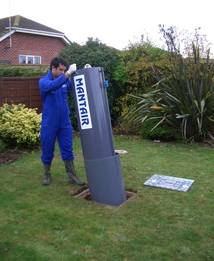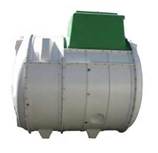Septic Tank ConversionSeptic tank conversion units are often the answer to solving septic tank problems. Septic tank conversion units are used to upgrade and modernise existing septic tanks and cesspools into fully functioning sewage treatment systems. These systems are mainly used where an existing septic tank is causing problems and the wastewater needs to be treated sufficiently to allow discharge to a ditch or stream. Consumer Notice! Beware of some commercial organisations making false claims regarding septic tank conversion systems. There are various ‘so called’ septic tank conversion units available in the U.K. These come in the form of systems which fit within the existing structure of the septic tank, sometimes referred to as ‘in tank’ systems, and systems which are installed and connected onto the outlet of an existing septic tank. The latter are marketed by manufactures as “septic tank conversion units”, but do not actually “convert” the existing tank and merely treat the overflow from the septic tank. The following information provides factual information relating to septic tank conversion units, including Environment Agency compliance.
Mantair Septic Tank Conversion Units The first septic tank conversion unit was designed over two decades ago by Andrew Skilling of Mantair Limited. As the original pioneers of the conversion unit concept, Mantair is still today the market leaders in the field of septic tank and cesspool upgrades.
With over 5000 units installed throughout the United Kingdom, Europe and West Africa, the Mantair system is regarded by many Regulators as the only reliable 'in tank' conversion unit. The Mantair septic conversion unit has been installed on various applications including National Trust Nature Reserves, SSSi and RAMSAR Sites. Mantair septic tank conversion units are purpose built to suit the existing tank dimensions and are professionally installed for customers through the Mantair Contracting Division or an official Licensed Installer. Prior to the installation of a Mantair unit, it is necessary for a trained Mantair engineer to visit site to determine if the existing septic tank is suitable for conversion. The majority of septic tanks are suitable for the installation of a Mantair unit. The long established principle of aerobic purification is at the heart of the Mantair septic tank conversion unit. The Mantair unit, when installed, converts the existing tank into a ‘two stage’ activated sludge sewage treatment system. The majority of the tank is aerated creating the correct environment for the growth of aerobic bacteria. The second stage is the final settlement zone where aerobic microorganisms and fine solids settle out and are returned to the aeration zone. The liquid remaining in the settlement zone is the treated effluent which is discharged from the system via the Final Effluent Airlift. The Environment Agency recognises the Mantair septic tank conversion unit as a sewage treatment system and provides Permit Certificates approving the discharge from these systems direct to ditches and streams. All Mantair units are designed to ensure that the completed installation complies with the requirements of the Environment Agency and Building Regulations. For further information on the Mantair conversion units, click here
D.I.Y. Septic Tank Conversion Units Since early 2012 many DIY septic tank conversion units have entered the marketplace, mainly by means of internet advertising. Companies advertising these systems claim these units convert existing septic tanks into fully functioning sewage treatment plants producing a treated effluent suitable for discharge to a watercourse. These systems however do not produce an effluent suitable for discharge to a ditch or stream as they have no means of separating the tank bacteria or fine solids from the effluent. DIY septic tank conversion systems operate by means of an air compressor which pumps air into a diffuser which is installed within the tank. These systems have no settlement zone and as a result the microorganisms and fine solids pass through the tank. This type of effluent is referred to as a ‘mixed liquor’ and is effectively the first stage of an aeration sewage treatment plant. After this, it is necessary for the effluent to enter some form of settlement zone, where the aerobic microorganisms and fine solids separate from the effluent. Only after this settlement stage takes place can the effluent possibly be suitable for discharge to a natural watercourse. As these septic tank conversion systems do not have a settlement zone they do not produce an effluent in compliance with Environment Agency requirements for discharge to a natural watercourse.
Add-On Septic Tank Conversion Units
These sewage treatment systems are an ideal solution to septic tanks problems where the existing tank is not suitable for the installation of a Mantair septic tank conversion unit.
Environment Agency Certification In April 2010 the Environment Agency introduced a new approval procedure for small discharges (maximum of 2M³/day to ground and 5M³ to watercourse). Under this new arrangement it is possible, under certain circumstances, to obtain an Exemption Certificate. This is a simplified procedure for which the Environment Agency does not charge an application fee. Amongst the conditions under which an Exemption Certificate can be obtained is that the receiving watercourse must normally contained water throughout the year. As the majority of discharges in rural areas are to seasonally dry ditches, they do not qualify for Exemption Certificates. In situations where the conditions for an Exemption Certificate cannot be met, it is necessary to apply for a Permit. This is a more detailed application procedure and the Environment Agency charge an application fee of £ 125. At the present time, if a discharge meets the conditions for an Exemption Certificate, it is not compulsory to register the discharge. If however, the conditions cannot be met, it is still necessary to apply for a Permit. Therefore, if you are proposing to discharge to a seasonally dry ditch, no matter what sewage treatment system you are intending to install you should be apply to the Environment Agency for a Permit.
For detailed information regarding Environment Agency Certification and Regulations, call us or e-mail for further information
© Mantair Limited 2011 |


 These types of systems do not convert existing septic tanks into sewage treatment plants, but do significantly improve the effluent quality which is discharged. These systems treat the overflow from the septic tank in a separate treatment stage involving the installation of an additional tank. The final effluent produced is suitable for discharge to a watercourse subject to Environment Agency approval.
These types of systems do not convert existing septic tanks into sewage treatment plants, but do significantly improve the effluent quality which is discharged. These systems treat the overflow from the septic tank in a separate treatment stage involving the installation of an additional tank. The final effluent produced is suitable for discharge to a watercourse subject to Environment Agency approval.